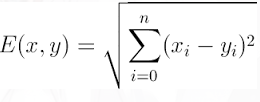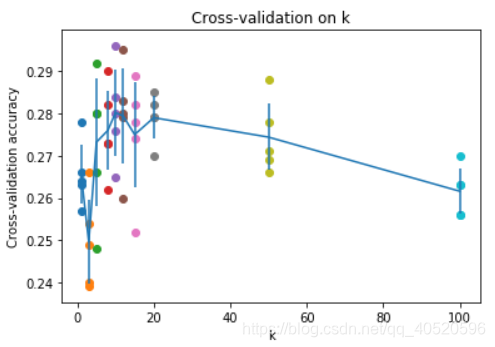CS231n:assignment1 KNN
一、前言
KNN属于无监督学习,也是整个机器学习中最简单粗暴一种,程序实现也非常容易。
kNN分类器分为两个阶段:
- 在训练过程中,分类器获取训练数据并简单地记住它;
- 在测试过程中,kNN将每个测试图像与所有的训练图像进行比较,并将k个最相似的训练图像的标签进行投票,从而决定该测试图像的类型;
具体分为两步:
①计算测试图像与训练图像每个像素点的欧氏距离
②将算得的距离进行排序,选取前k个训练图像的label,进而预测该测试图像的label - k的值是交叉验证的。
二、主要部分程序解读
1、数据输入
#------------------------------knn文件----------------------------------
# Load the raw CIFAR-10 data.
cifar10_dir = 'cs231n/datasets/cifar-10-batches-py'
X_train, y_train, X_test, y_test = load_CIFAR10(cifar10_dir)
# As a sanity check, we print out the size of the training and test data.
print('Training data shape: ', X_train.shape) #Training data shape: (50000, 32, 32, 3)
print('Training labels shape: ', y_train.shape) #Training labels shape: (50000,)
print('Test data shape: ', X_test.shape) #Test data shape: (10000, 32, 32, 3)
print('Test labels shape: ', y_test.shape) #Test labels shape: (10000,)
结果:将之前下载的cifar10_dir的数据读入进来,根据结果显示可知:
input: X_train(50000,32,32,3) y_train(50000, )
X_test(10000,32,32,3) y_test(10000, )
X_train与X_test是图片数据,而y_train和y_test则是对应图片的标签。
2、数据更新
#------------------------------knn文件----------------------------------
# Subsample the data for more efficient code execution in this exercise
num_training = 5000
mask = list(range(num_training))
X_train = X_train[mask]
y_train = y_train[mask]
num_test = 500
mask = list(range(num_test))
X_test = X_test[mask]
y_test = y_test[mask]
之前读入50000张图片,但对于KNN只需要少部分进行训练,因为是无监督学习,这里选取5000张来进行训练,用500张来进行测试
input: X_train(5000,32,32,3) y_train(5000, )
X_test(500,32,32,3) y_test(500, )
结果:更新数据,X_train与X_test变成训练图片的前5000张以及测试图片前500张图片数据,而y_train和y_test则是对应图片的标签。
#------------------------------knn文件----------------------------------
# Reshape the image data into rows
X_train = np.reshape(X_train, (X_train.shape[0], -1)) #等效为X_train = X_train.reshape(X_train.shape[0], -1))
X_test = np.reshape(X_test, (X_test.shape[0], -1)) #等效为X_test = X_test.reshape(X_test.shape[0], -1))
print(X_train.shape, X_test.shape) #(5000, 3072) (500, 3072)
更新之前读入的数据读入进来,根据结果显示可知:
input: X_train(5000,3072) y_train(5000, )
X_test(500,3072) y_test(500, )
结果:这一步就是为了让更新后的X_train与X_test由多维变成二维矩阵
3、KNN分类器实现
我们用kNN分类器对测试数据进行分类。这个过程分成两个步骤:
- 首先,我们必须计算所有测试样本和所有训练样本之间的L2距离;
- 得到这些距离后,对于每个测试样本,我们找到k个最近的样本,并让这k个样本标签来为测试样本预测的标签进行投票;
3.1 训练分类器
首先最开始则是训练分类器。对于k近邻来说训练就是记忆训练数据,因此只需将数据导入即可。
#------------------------------knn文件----------------------------------
from cs231n.classifiers import KNearestNeighbor
# Create a kNN classifier instance.
# Remember that training a kNN classifier is a noop: 翻译--->记住,训练kNN分类器是一个空操作
# the Classifier simply remembers the data and does no further processing 翻译--->分类器只记住数据,不做进一步的处理
classifier = KNearestNeighbor() #KNearestNeighbor()是一个类,定义在cs231n/classifiers/k_nearest_neighbor.py中
classifier.train(X_train, y_train) #调用KNearestNeighbor中的train方法
以下是KNearestNeighbor类的一部分,可以看出train方法只是将数据输入,以满足后序方法数据需要。
#------------------------k_nearest_neighbor.py文件----------------------------------
import numpy as np
from past.builtins import xrange
class KNearestNeighbor(object):
""" a kNN classifier with L2 distance """
def __init__(self):
pass
def train(self, X, y):
"""
Train the classifier. For k-nearest neighbors this is just
memorizing the training data.
Inputs:
- X: A numpy array of shape (num_train, D) containing the training data
consisting of num_train samples each of dimension D.
- y: A numpy array of shape (N,) containing the training labels, where
y[i] is the label for X[i].
"""
self.X_train = X
self.y_train = y
3.2 计算欧式距离L2

中心思想:计算第i幅测试以及第j幅训练图之间距离,将所得值保存在dists[ i ][ j ]中,结果是一个矩阵,第i行是测试图i与所有训练图之间的L2距离,所有总行数等于测试图数X_test.shape[0]=500,总列数等于训练图数X_train.shape[0]=5000。

3.2.1 用两个循环来计算欧式L2距离
At first, open cs231n/classifiers/k_nearest_neighbor.py and implement the function compute_distances_two_loops.
#------------------------k_nearest_neighbor.py文件----------------------------------
def compute_distances_two_loops(self, X):
"""
Compute the distance between each test point in X and each training point
in self.X_train using a nested loop over both the training data and the
test data.
Inputs:
- X: A numpy array of shape (num_test, D) containing test data.
Returns:
- dists: A numpy array of shape (num_test, num_train) where dists[i, j]
is the Euclidean distance between the ith test point and the jth training
point.
"""
num_test = X.shape[0]
num_train = self.X_train.shape[0]
dists = np.zeros((num_test, num_train))
for i in xrange(num_test): #测试样本的循环
for j in xrange(num_train): #训练样本的循环
#####################################################################
# TODO: #
# Compute the l2 distance between the ith test point and the jth #计算欧式距离l2
# training point, and store the result in dists[i, j]. You should #
# not use a loop over dimension. #
#####################################################################
dists[i][j] = np.sqrt(np.sum(np.square(self.X_train[j,:] - X[i,:])))
#####################################################################
# END OF YOUR CODE #
#####################################################################
return dists
3.2.2 用一个循环来计算欧式L2距离
At first, open cs231n/classifiers/k_nearest_neighbor.py and implement the function compute_distances_one_loop.
#------------------------k_nearest_neighbor.py文件----------------------------------
def compute_distances_one_loop(self, X):
"""
Compute the distance between each test point in X and each training point
in self.X_train using a single loop over the test data.
Input / Output: Same as compute_distances_two_loops
"""
num_test = X.shape[0]
num_train = self.X_train.shape[0]
dists = np.zeros((num_test, num_train))
for i in xrange(num_test):
#######################################################################
# TODO: #
# Compute the l2 distance between the ith test point and all training #
# points, and store the result in dists[i, :]. #
#######################################################################
dists[i,:] = np.sqrt(np.sum(np.square(self.X_train-X[i,:]),axis = 1)) # 1
#######################################################################
# END OF YOUR CODE #
#######################################################################
return dists
程序解读:
- #1:self.X_train-X[i,:]------->由于self.X_train是(5000,3072),而X[i,:]是X的第i行,即(1,3072),这个相减则是将X[i,:]延展成(5000,3072),每一行都与第一行一样,最后结果(5000,3072)就是每一幅训练图都与第i幅测试图进行相减;
- #1:np.sum(np.square(self.X_train-X[i,:]),axis = 1)--------->进行行求和,最后结果是(5000, )。
Q1: 这里我一直没想通为什么维度会改变,从原来的二维变成一维,按正常思路:将(5000,3072)进行行求和,那么结果一定是(5000,1),这个就是列向量,怎么可能赋值给行向量dists[i,:]?
Answer:后来经过尝试发现sum会自动降维,(5000,3072)进行行求和,结果是(5000, ),如果要保持维度不发生变化,则用语句np.sum(np.square(self.X_train-X[i,:]),axis = 1,keepdims=True),这时sum就不会自动降维,结果仍旧是二维,shape=(5000, 1),最后,由于结果自动降维成(5000, ),它既不是行向量也不是列向量,因此既可以赋给行向量,也可以赋给列向量。
3.2.3 不使用循环,直接计算欧式L2距离
At first, open cs231n/classifiers/k_nearest_neighbor.py and implement the function compute_distances_no_loops.
#------------------------k_nearest_neighbor.py文件----------------------------------
def compute_distances_no_loops(self, X):
"""
Compute the distance between each test point in X and each training point
in self.X_train using no explicit loops.
Input / Output: Same as compute_distances_two_loops
"""
num_test = X.shape[0]
num_train = self.X_train.shape[0]
dists = np.zeros((num_test, num_train))
#########################################################################
# TODO: #
# Compute the l2 distance between all test points and all training #
# points without using any explicit loops, and store the result in #
# dists. #
# #
# You should implement this function using only basic array operations; #
# in particular you should not use functions from scipy. #
# #
# HINT: Try to formulate the l2 distance using matrix multiplication #
# and two broadcast sums. #
#########################################################################
mul1 = np.multiply(np.dot(X,self.X_train.T),-2) # 1
sq1 = np.sum(np.square(X),axis=1,keepdims = True) # 2
sq2 = np.sum(np.square(self.X_train),axis=1) # 3
dists = mul1+sq1+sq2
dists = np.sqrt(dists) #通过 x^2 - 2xy + y^2 = (x-y)^2 来实现
#########################################################################
# END OF YOUR CODE #
#########################################################################
return dists
程序解读:
- #1:相当于求 " -2xy ";
- #2:相当于求" x^2 ";
- #3:相当于求" y^2 "。
最后结果可以知道mul1.shape=(500,5000),sq1.shape=(500,1),sq2.shape=(5000, )
Q2: 三个规格不相同的向量进行相加,怎么进行?
Answer:还是通过尝试发现(sq1+sq2).shape=(500,5000)
Eg:一维向量和列向量相加的运算!!!
In : c = np.array([1,2,3,4]) #c.shape = (4, )
Out: [1 2 3 4]
In : a = c.reshape((4,1)) #a.shape = (4,1)
Out: [[1]
[2]
[3]
[4]]
In : print(c+a) #(c+a).shape = (4,4)
Out: [[2 3 4 5]
[3 4 5 6]
[4 5 6 7]
[5 6 7 8]]
3.3 分类器预测
#------------------------k_nearest_neighbor.py文件----------------------------------
def predict_labels(self, dists, k=1):
"""
Given a matrix of distances between test points and training points,
predict a label for each test point.
Inputs:
- dists: A numpy array of shape (num_test, num_train) where dists[i, j]
gives the distance betwen the ith test point and the jth training point.
Returns:
- y: A numpy array of shape (num_test,) containing predicted labels for the
test data, where y[i] is the predicted label for the test point X[i].
"""
num_test = dists.shape[0]
y_pred = np.zeros(num_test)
for i in xrange(num_test):
# A list of length k storing the labels of the k nearest neighbors to
# the ith test point.
closest_y = []
#########################################################################
# TODO: #
# Use the distance matrix to find the k nearest neighbors of the ith #
# testing point, and use self.y_train to find the labels of these #
# neighbors. Store these labels in closest_y. #
# Hint: Look up the function numpy.argsort. #
#########################################################################
closest_y = self.y_train[np.argsort(dists[i,:])[:k]] # 1
#########################################################################
# TODO: #
# Now that you have found the labels of the k nearest neighbors, you #
# need to find the most common label in the list closest_y of labels. #
# Store this label in y_pred[i]. Break ties by choosing the smaller #
# label. #
#########################################################################
y_pred[i] = np.argmax(np.bincount(closest_y)) # 2
#########################################################################
# END OF YOUR CODE #
#########################################################################
return y_pred
程序解读:
- #1:np.argsort(dists[i,:])[:k] :将dists第i行的数值进行处理,将该行元素值从小到大排序(为什么从小到大?因为越小说明越相近),然后返回它们索引值来组成一个数组(1,5000),最后取前k列;目的在于选k张与测试图片最相近的训练图片出来。其中closest_y (1, k);
- #1:self.y_train[np.argsort(dists[i,:])[:k]]:这个将得到这k张训练图片的label值;
- #2:np.bincount(closest_y):得到所有索引值(种类如果是k+1种,则索引值0~k)在closest_y中出现的次数,将次数组成一个数组,故大小则是(1,k+1);
- #2:np.argmax(np.bincount(closest_y)):argmax用来求出数组中元素最大值所对应的索引,因此返回一个值,该值则是最终预测的label的索引值,其实索引值就是label值,返回索引就够了,没必要转成label名称,最后存到y_pred[i]中。
4、KNN结果展示
4.1 用颜色深浅形式查看dists元素值
#------------------------------knn文件----------------------------------
# We can visualize the distance matrix: each row is a single test example and
# its distances to training examples
plt.imshow(dists, interpolation='none')
plt.show()
上述代码中interpolation代表的是插值运算,'none’是选取的是不插值方式,将dists的每个元素展示出来,结果如下:

从上面图片看,如果第i行越黑,则说明第i张测试图和所有训练图相似,越亮则越不相似;若第j列越黑则说明第j张训练图和所有测试图越相似
4.2 计算准确度(k=1)
#------------------------------knn文件----------------------------------
# Now implement the function predict_labels and run the code below:
# We use k = 1 (which is Nearest Neighbor).
y_test_pred = classifier.predict_labels(dists, k=1)
# Compute and print the fraction of correctly predicted examples
num_correct = np.sum(y_test_pred == y_test)
accuracy = float(num_correct) / num_test
print('Got %d / %d correct => accuracy: %f' % (num_correct, num_test, accuracy))
程序解读:
- 先令k=1,即最近邻为1;
- 将这500张测试图片预测完label后,与准确的label值进行比较,若一样则得分为1,不一样则得分为0,最后除以500,得到的就是准确度。
4.3 计算准确度(k=5)
#------------------------------knn文件----------------------------------
y_test_pred = classifier.predict_labels(dists, k=5)
num_correct = np.sum(y_test_pred == y_test)
accuracy = float(num_correct) / num_test
print('Got %d / %d correct => accuracy: %f' % (num_correct, num_test, accuracy))
程序解读:
- 再令k=5,最近邻改为5,重复之前k=1的工作;
- 将这500张测试图片预测完label后,与准确的label值进行比较,若一样则得分为1,不一样则得分为0,最后除以500,得到的就是准确度。
5、交叉验证确定k值
之前我们已经实现了k近邻分类器,但是我们是随意设置 k 的值。接下来我们将通过交叉验证来确定这个超参数的最佳值。我们采用S折交叉验证的方法,即将数据平均分成S份,一份作为测试集,其余作为训练集,一般S=10,本文将S设为5,即代码中num_folds = 5。
5.1 交叉验证
#------------------------------knn文件----------------------------------
num_folds = 5
k_choices = [1, 3, 5, 8, 10, 12, 15, 20, 50, 100]
X_train_folds = []
y_train_folds = []
################################################################################
# TODO: #
# Split up the training data into folds. After splitting, X_train_folds and #
# y_train_folds should each be lists of length num_folds, where #
# y_train_folds[i] is the label vector for the points in X_train_folds[i]. #
# Hint: Look up the numpy array_split function. #
################################################################################
y_train_ = y_train.reshape(-1, 1)
X_train_folds = np.array_split(X_train, 5) # 1
y_train_folds = np.array_split(y_train_, 5)
################################################################################
# END OF YOUR CODE #
################################################################################
# A dictionary holding the accuracies for different values of k that we find
# when running cross-validation. After running cross-validation,
# k_to_accuracies[k] should be a list of length num_folds giving the different
# accuracy values that we found when using that value of k.
k_to_accuracies = {} # 2
################################################################################
# TODO: #
# Perform k-fold cross validation to find the best value of k. For each #
# possible value of k, run the k-nearest-neighbor algorithm num_folds times, #
# where in each case you use all but one of the folds as training data and the #
# last fold as a validation set. Store the accuracies for all fold and all #
# values of k in the k_to_accuracies dictionary. #
################################################################################
for k_ in k_choices:
k_to_accuracies.setdefault(k_, [])
for i in range(num_folds): # 3
classifier = KNearestNeighbor()
X_val_train = np.vstack(X_train_folds[0:i] + X_train_folds[i+1:]) # 4
y_val_train = np.vstack(y_train_folds[0:i] + y_train_folds[i+1:])
y_val_train = y_val_train[:,0]
classifier.train(X_val_train, y_val_train)
for k_ in k_choices:
y_val_pred = classifier.predict(X_train_folds[i], k=k_) # 5
num_correct = np.sum(y_val_pred == y_train_folds[i][:,0])
accuracy = float(num_correct) / len(y_val_pred)
k_to_accuracies[k_] = k_to_accuracies[k_] + [accuracy]
################################################################################
# END OF YOUR CODE #
################################################################################
# Print out the computed accuracies
for k in sorted(k_to_accuracies): # 6
for accuracy in k_to_accuracies[k]:
print('k = %d, accuracy = %f' % (k, accuracy))
程序解读:
- #1:表示将数据训练集平均分成5份,对应的标签也分为5份;
- #2:以字典形式存储k 和accuracy;
- #3:依次对每个k (1,3,5,8,10,12,15,20,50,100)值,选取一份测试,其余训练,计算准确率,由于之前平均分为5份,故对每个k都有五个结果;
- #4:表示除 i 之外的作为训练集;
- #5:将第 i 份作为测试集并预测;
- #6:输出每个k值五次得到的准确率。
结果:
k = 1, accuracy = 0.263000
k = 1, accuracy = 0.257000
k = 1, accuracy = 0.264000
k = 1, accuracy = 0.278000
k = 1, accuracy = 0.266000
k = 3, accuracy = 0.239000
k = 3, accuracy = 0.249000
k = 3, accuracy = 0.240000
k = 3, accuracy = 0.266000
k = 3, accuracy = 0.254000
k = 5, accuracy = 0.248000
k = 5, accuracy = 0.266000
k = 5, accuracy = 0.280000
k = 5, accuracy = 0.292000
k = 5, accuracy = 0.280000
k = 8, accuracy = 0.262000
k = 8, accuracy = 0.282000
k = 8, accuracy = 0.273000
k = 8, accuracy = 0.290000
k = 8, accuracy = 0.273000
k = 10, accuracy = 0.265000
k = 10, accuracy = 0.296000
k = 10, accuracy = 0.276000
k = 10, accuracy = 0.284000
k = 10, accuracy = 0.280000
k = 12, accuracy = 0.260000
k = 12, accuracy = 0.295000
k = 12, accuracy = 0.279000
k = 12, accuracy = 0.283000
k = 12, accuracy = 0.280000
k = 15, accuracy = 0.252000
k = 15, accuracy = 0.289000
k = 15, accuracy = 0.278000
k = 15, accuracy = 0.282000
k = 15, accuracy = 0.274000
k = 20, accuracy = 0.270000
k = 20, accuracy = 0.279000
k = 20, accuracy = 0.279000
k = 20, accuracy = 0.282000
k = 20, accuracy = 0.285000
k = 50, accuracy = 0.271000
k = 50, accuracy = 0.288000
k = 50, accuracy = 0.278000
k = 50, accuracy = 0.269000
k = 50, accuracy = 0.266000
k = 100, accuracy = 0.256000
k = 100, accuracy = 0.270000
k = 100, accuracy = 0.263000
k = 100, accuracy = 0.256000
k = 100, accuracy = 0.263000
5.2 结果展示
将每个k下的五个准确率求平均后,用图片展示,从图中就可以直观看出k的最佳值,如图,当k=10 时,准确率最高。
#------------------------------knn文件----------------------------------
# plot the raw observations
for k in k_choices:
accuracies = k_to_accuracies[k]
plt.scatter([k] * len(accuracies), accuracies)
# plot the trend line with error bars that correspond to standard deviation
accuracies_mean = np.array([np.mean(v) for k,v in sorted(k_to_accuracies.items())])
accuracies_std = np.array([np.std(v) for k,v in sorted(k_to_accuracies.items())])
plt.errorbar(k_choices, accuracies_mean, yerr=accuracies_std)
plt.title('Cross-validation on k')
plt.xlabel('k')
plt.ylabel('Cross-validation accuracy')
plt.show()

